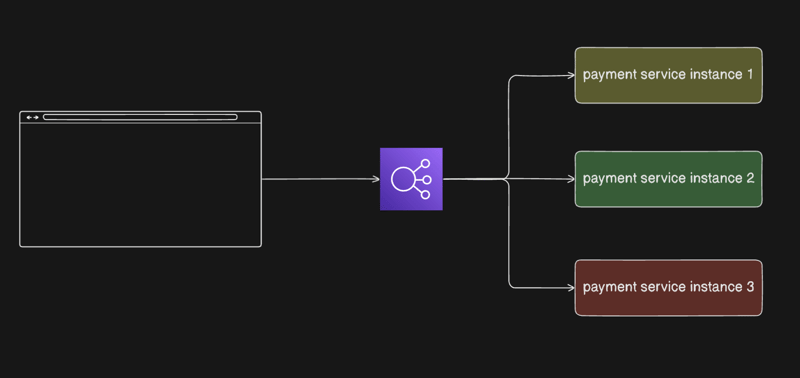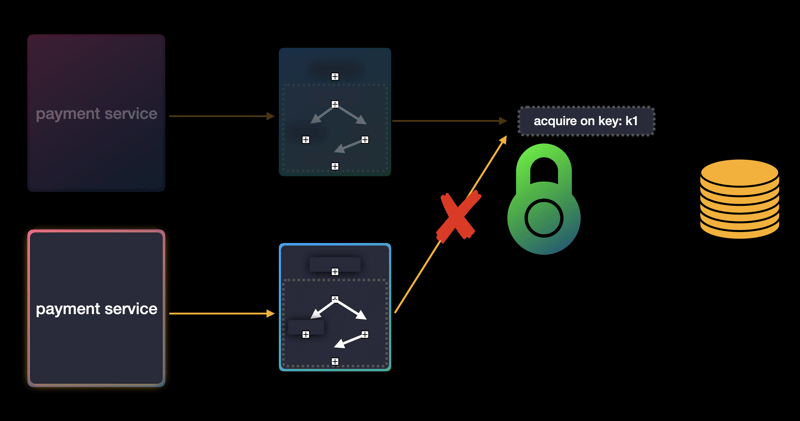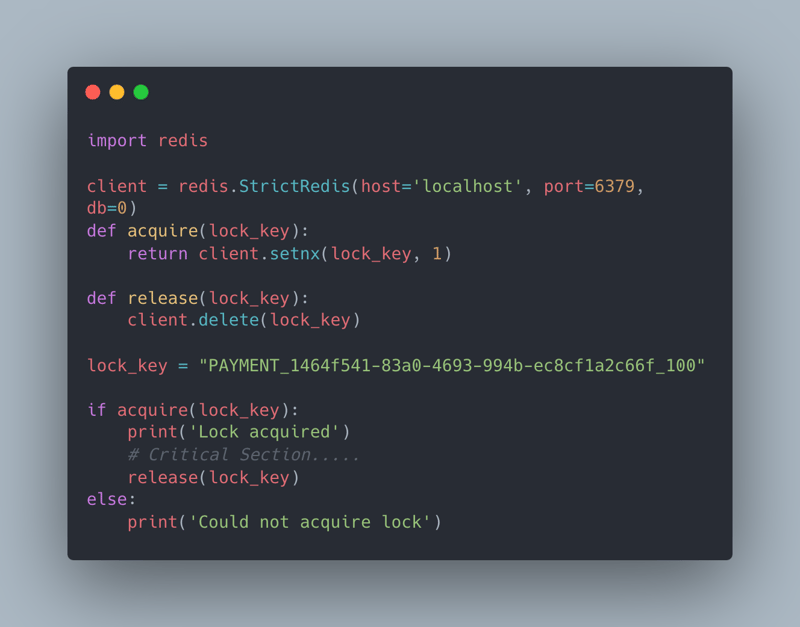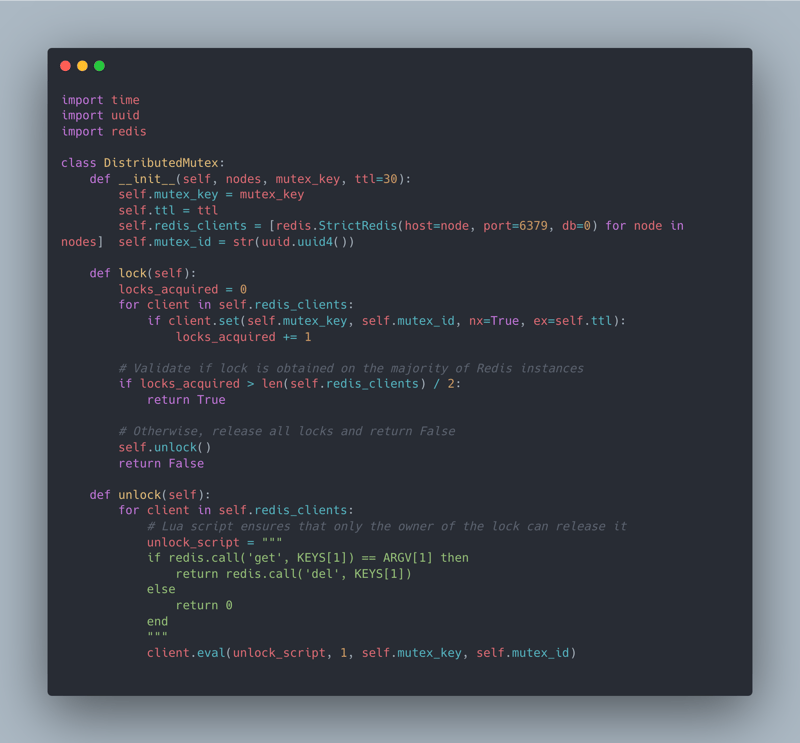How to implement a Distributed Lock using Redis
I am Dumb
Well, whenever we work in our local system everything works as butter. That is why we call "No better place than 127.0.0.1" but WAKE UP TO THE REALITY

Well things not always work in production as expected. Mostly when you are running multiple instances of your application.

? As you can see that if multiple instances of our application are running and let's say that our client make a request to mark a user as a paid user in our DB.
- Client will request our server
- Request will reach at our load balancer
- And one of the instance will get the request and will make a write query into our DB
It seems alright right? No problem till now right.
Well, yes till now there is no problem. But what if we want to write a business logic like:-
- fetch the user from the DB
- check if user is a free user or already paid
- if free, then mark it paid and save in the db
- if paid, send "Already paid" in the response.
⚡️ As we know that (assume we are using MySQL here) MySQL DBs are ACID compliant which means any query will be atomic and isolated. which means MySQL query will be run in atomic way, either it will pass or fail. But it will not quit in between.
? But there is one issue here. Think, Think....
- Step 1: We are fetching user (Atomic transaction)
- Step 2: Running some business logic in the code
- Step 3: Updating the MySQL record if user not paid (Atomic transaction)
What will happen if at Step 2, one more request comes to cancel the payment, and then that query runs first and marks user as free, then step 3 runs and user marked as Paid.
?? Hurray, User got access to our Products without even paying.
Locking
✅ Here comes the saviour, Locks

? Lock is a structure that allows only one thread at a time to enter a critical section (block of code that should not be accessed by multiple workers i.e. threads)
Hence, we will acquire lock before and release after the completion of the operation:-
- Step 0: try-acquire() lock
- Step 1: If acquired, We are fetching user (Atomic transaction)
- Step 2: Running some business logic in the code
- Step 3: Updating the MySQL record if user not paid (Atomic transaction)
- Step 4: release() the lock
? Problem
Now, here comes the problem which is if we will use some in memory lock data structure or any memory based lock it will be eligible for one instance for our application. what about the other instances running the same code and updating in the DB?
Well here comes the concept of Distributed locking
? Distributed Locking

Here lock acts as a centralised service, where if one instance of our service acquires the lock then others can't on the same key.
WHAT KEY COULD BE HERE IN PAYMENT SERVICE?
? For a user making payment key could be the combination of = "PAYMENT_" + user_id + amount
And this will be unique per user. And this key will remain same in case of user making payment or cancelling payment. Hence when one is happening other action can't proceed because both actions will try to acquire on same key.
? What what the heck is Key, Acquire lock, release lock. And most importantly how redis is being in use?
? Using Redis to implement Distributed Locking
Using a single instance of Redis:-

But here are the few problems with a single redis instance:-
- A single instance may fail & lock acquired may not be released
- If two instances are used (master-replica) when one client will acquire lock on one instance
- master has to communicate the same with replica to sync. This communication itself is an async communication
? So, if lock is acquired on master, and while communication to replica if master goes down before syncing with replica. Replica will become master where Lock on the same key will be available to acquire that was acquired on the master earlier.
Two instances of our services will be able to acquire the lock on redis even having two instances (master-replica).
Using Redlock Algorithm:-
Acquiring Lock:- We will try to acquire lock on multiple redis instances with lock expiration time
Validation of Lock:- lock will be considered as acquired if major redis instances got lock acquired for the client
Releasing Lock:- When releasing the lock, all instances releases the lock

And yes that's it.
❤️ Thanks for the read, and subscribe to our newsletter for more such articles:- https://www.serversidedigest.com/
For more information:-
- Jedis in Java:- https://redis.io/docs/latest/develop/connect/clients/java/jedis/
- Redis Client in Golang:- https://github.com/redis/go-redis
The above is the detailed content of How to implement a Distributed Lock using Redis. For more information, please follow other related articles on the PHP Chinese website!

Hot AI Tools

Undresser.AI Undress
AI-powered app for creating realistic nude photos

AI Clothes Remover
Online AI tool for removing clothes from photos.

Undress AI Tool
Undress images for free

Clothoff.io
AI clothes remover

Video Face Swap
Swap faces in any video effortlessly with our completely free AI face swap tool!

Hot Article

Hot Tools

Notepad++7.3.1
Easy-to-use and free code editor

SublimeText3 Chinese version
Chinese version, very easy to use

Zend Studio 13.0.1
Powerful PHP integrated development environment

Dreamweaver CS6
Visual web development tools

SublimeText3 Mac version
God-level code editing software (SublimeText3)

Hot Topics
 1664
1664
 14
14
 1421
1421
 52
52
 1315
1315
 25
25
 1266
1266
 29
29
 1239
1239
 24
24
 Is the company's security software causing the application to fail to run? How to troubleshoot and solve it?
Apr 19, 2025 pm 04:51 PM
Is the company's security software causing the application to fail to run? How to troubleshoot and solve it?
Apr 19, 2025 pm 04:51 PM
Troubleshooting and solutions to the company's security software that causes some applications to not function properly. Many companies will deploy security software in order to ensure internal network security. ...
 How do I convert names to numbers to implement sorting and maintain consistency in groups?
Apr 19, 2025 pm 11:30 PM
How do I convert names to numbers to implement sorting and maintain consistency in groups?
Apr 19, 2025 pm 11:30 PM
Solutions to convert names to numbers to implement sorting In many application scenarios, users may need to sort in groups, especially in one...
 How to simplify field mapping issues in system docking using MapStruct?
Apr 19, 2025 pm 06:21 PM
How to simplify field mapping issues in system docking using MapStruct?
Apr 19, 2025 pm 06:21 PM
Field mapping processing in system docking often encounters a difficult problem when performing system docking: how to effectively map the interface fields of system A...
 How does IntelliJ IDEA identify the port number of a Spring Boot project without outputting a log?
Apr 19, 2025 pm 11:45 PM
How does IntelliJ IDEA identify the port number of a Spring Boot project without outputting a log?
Apr 19, 2025 pm 11:45 PM
Start Spring using IntelliJIDEAUltimate version...
 How to elegantly obtain entity class variable names to build database query conditions?
Apr 19, 2025 pm 11:42 PM
How to elegantly obtain entity class variable names to build database query conditions?
Apr 19, 2025 pm 11:42 PM
When using MyBatis-Plus or other ORM frameworks for database operations, it is often necessary to construct query conditions based on the attribute name of the entity class. If you manually every time...
 How to safely convert Java objects to arrays?
Apr 19, 2025 pm 11:33 PM
How to safely convert Java objects to arrays?
Apr 19, 2025 pm 11:33 PM
Conversion of Java Objects and Arrays: In-depth discussion of the risks and correct methods of cast type conversion Many Java beginners will encounter the conversion of an object into an array...
 E-commerce platform SKU and SPU database design: How to take into account both user-defined attributes and attributeless products?
Apr 19, 2025 pm 11:27 PM
E-commerce platform SKU and SPU database design: How to take into account both user-defined attributes and attributeless products?
Apr 19, 2025 pm 11:27 PM
Detailed explanation of the design of SKU and SPU tables on e-commerce platforms This article will discuss the database design issues of SKU and SPU in e-commerce platforms, especially how to deal with user-defined sales...
 How to use the Redis cache solution to efficiently realize the requirements of product ranking list?
Apr 19, 2025 pm 11:36 PM
How to use the Redis cache solution to efficiently realize the requirements of product ranking list?
Apr 19, 2025 pm 11:36 PM
How does the Redis caching solution realize the requirements of product ranking list? During the development process, we often need to deal with the requirements of rankings, such as displaying a...




